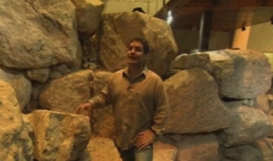
A leading British archaeologist believes he may have found the house that Jesus grew up in.
Dr Ken Dark of the University of Reading set up the Nazareth Archaeological Project in 2004, and in 2006 discovered the potential significance of a house that had been dug up in the 19th century by nuns at the Sisters of Nazareth Convent.
The house was cut into a rocky hillside, and located beneath the convent. It has now been identified as a genuine first century structure, Dark told Christian Today, more than 100 years since its discovery.
"It just happened that for a range of reasons, no actual archaeologist had studied the site, and so the significance and date of it had not been realised," he said.
An ancient text written by Irish monk Adomnan in the 7<sup>th century links the site to Jesus' childhood. It describes a church "where once there was the house in which the Lord was nourished in his infancy'.
Dark believes that the site is the house that the Byzantines – the people of the eastern Roman Empire – believed to be the home of Jesus.
"They liked to build churches, particularly impressive ones, in holy locations associated...with events or personalities in the Gospels, and so there was a Byzantine church built over the tomb of Christ in Jerusalem, and another at Bethlehem and so on," he said.
"We know that Nazareth had two impressive churches – one at the Church of the Annunciation, which is still the great cathedral of Nazareth, and near that one, another called the Church of the Nutrition, meaning the upbringing of Christ."
It is this church that is described by Adomnan, and that Dark now believes he has identified.
"The Church of the Nutrition is described as having a vaulted crypt in the cellar, in which our Lord grew up. Underneath the remains of the Byzantine church there was a crypt, and in that crypt, among other things, there was the house that is now attracting all the attention. What is really exciting is that it can be dated to the 1st century."
Claims that biblical sites have been found are made frequently, however, and are often considered to be unfounded. Dark wrote in the Biblical Archaeology Review that it is impossible to verify on archaeological grounds that the site actually is that of Jesus' upbringing.
"On the other hand, there is no good archaeological reason why such an identification should be discounted," he said.
"The strength of this [research] is that every element is based on normal, conventional, archaeological dating and reasoning, done by professional archaeologists in the same way that we would examine a site in Britain, Germany or anywhere else," he told Christian Today.

"This is a straightforward piece of archaeological investigation, and so if we can establish on that basis the date of the church and of the house, and by comparing that evidence with the written evidence the identity of the church, that raises the possibility that this really is the house of Jesus."
No known serious scholar doubts that a person by the name of Jesus of Nazareth lived in the region in the early 1st century, Dark added.
"With any other scholar competent to judge the matter, I take Nazareth to have been a real village and Jesus of Nazareth a real person," leading historian Larry Hurtado responded to the suggestion that Jesus may not have existed.
"Nobody who's a serious scholar working on that period, whatever their own personal religious or ideological views, doubts that Nazareth was there, and the historical figure called Jesus of Nazareth came from that Nazareth," Dark added.














